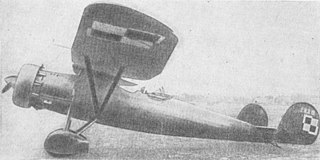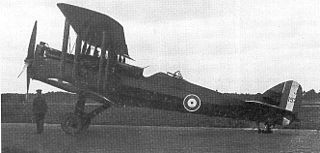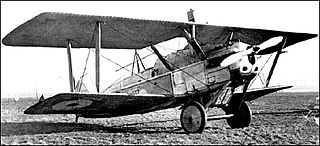
The Hawker Harrier was a British experimental biplane torpedo bomber aircraft built by Hawker Aircraft to a specification issued in the 1920s for the Royal Air Force.
The Martin XB-68 was a supersonic medium tactical bomber with a crew of two that was proposed in 1954 to the United States Air Force. The project, however, was canceled before any aircraft were built.

The Vickers Type 131 Valiant was a British general-purpose biplane produced by Vickers in 1927, with the intention of replacing the Royal Air Force's Airco DH.9As, but was unsuccessful, with only a single example built, which was sold to Chile.

The Hawker P.V.4 was a 1930s British biplane aircraft built by Hawker Aircraft in competition for a government order for a general-purpose military aircraft.

The Fairey Gordon was a British light bomber and utility aircraft of the 1930s.

The British "Victory Bomber" was a Second World War design proposal by British inventor and aircraft designer Barnes Wallis while at Vickers-Armstrongs for a large strategic bomber. This aircraft was to have performed what Wallis referred to as "anti-civil engineering" bombing missions and was to have carried his projected 22,000 lb (10,000 kg) "earthquake bomb" to strategic targets in Nazi Germany. The Victory Bomber was considered extremely ambitious: the Royal Air Force (RAF) at that time not yet having introduced four-engine heavy bombers, to give the necessary performance, the Victory Bomber was to have six engines and was highly specialised to its role.

The PWS-19 was a Polish reconnaissance and bomber plane prototype of the 1930s, constructed in the PWS.

The de Havilland DH.14 Okapi was a British two-seat day bomber of the 1910s built by de Havilland. The aircraft was designed as an Airco DH.4 and DH.9 replacement, but it never entered production.

The Kawanishi E7K was a Japanese three-seat reconnaissance seaplane mainly in use during the 1930s. It was allocated the reporting name Alf by the Allies of World War II.

The CA-11 Woomera was a production development of the earlier CA-4 Wackett Bomber prototype, and was an Australian torpedo and dive bomber aircraft that was designed and constructed by the Commonwealth Aircraft Corporation (CAC) during World War II. The order for the Woomera was cancelled before it became operational with the Royal Australian Air Force (RAAF).

The Bristol Boarhound was a British army cooperation and liaison aircraft of the 1920s. It was a two-seat biplane with wings of equal span and a steel frame construction with fabric covering.

The Vickers Type 94 Venture was a British army cooperation biplane of the 1920s, designed and built by Vickers, as a development of the Vixen. While six were built for the Royal Air Force, they were found unsuitable and were used for experimental work.

The Vickers Type 163 was a prototype British biplane bomber design of the 1930s, built by Vickers-Armstrong.
The Nakajima Ki-19 was an unsuccessful attempt by Nakajima Aircraft Company to meet a 1935 requirement issued by the Japanese government for a modern bomber to replace the Mitsubishi Ki-1 heavy bomber.
The Tupolev TB-6 was a proposal by the Tupolev Design Bureau in the 1930s for a super-heavy bomber. Had it been built, it would have been the biggest-ever Soviet bomber and the largest aircraft by wingspan of its time, nine feet short of the 320 foot span of the Hughes H-4 Hercules, although the Scaled Composites Stratolaunch is now the biggest plane by wingspan.

The Armstrong Whitworth A.W.19 was a two/three-seat single-engine biplane, built as a general-purpose military aircraft in the mid-1930s. A newer, monoplane aircraft was preferred and only one A.W.19 was built.

The Vickers Type 207 was a single-engined two-seat biplane designed as a shipborne torpedo bomber to an early 1930s specification. Structurally innovative, only one was built.

The Vickers Type 253 was a single-engined two-seat biplane general-purpose military machine, built to a 1930 government specification. It won a production contract, but this was transferred to the same company's monoplane equivalent, the Wellesley. Only one Type 253 was built.

The Fairey G.4/31 was a British single-engined, two-seat biplane contender for an Air Ministry specification for a multi-role or general purpose aircraft. Unsuccessful, only one was built.

The Vickers E.S.1 was an early British Fighter aircraft of the First World War. A single-seat biplane, only three E.S.1s were built, although at least one was used by a home defence squadron of the Royal Flying Corps.
















